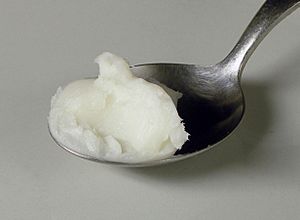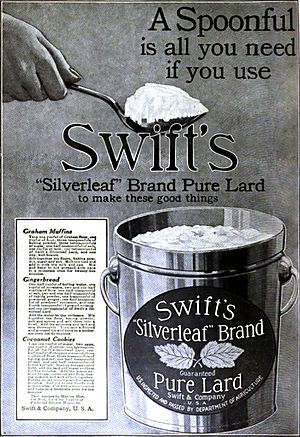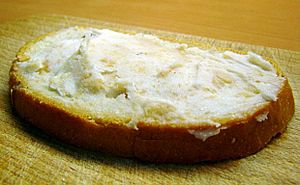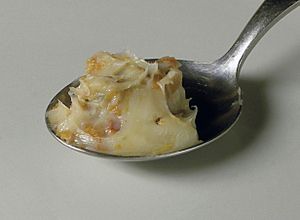Lard facts for kids
Lard is pig fat that is used in cooking. Before, many cuisines used it as a cooking fat or shortening, or as a spread similar to butter. It is not used as much as before. Many cooks and bakers still like it better than other fats for some things.
Contents
Culinary use
Lard is one of the few edible oils with a relatively high smoke point, attributable to its high saturated fatty acids content. Pure lard is especially useful for cooking since it produces little smoke when heated and has a distinct flavor when combined with other foods. Many chefs and bakers prize lard over other types of shortening because of its flavor and range of applications.
Because of the relatively large fat crystals found in lard, it is extremely effective as a shortening in baking. Pie crusts made with lard tend to be flakier than those made with butter. Many cooks employ both types of fat in their pastries to combine the shortening properties of lard with the flavor of butter.
Lard was once widely used in the cuisines of Europe, China and the New World and still plays a significant role in British, Central European, Mexican and Chinese cuisines. In British cuisine, lard is a traditional ingredient in mince pies and Christmas puddings, lardy cake and for frying fish and chips as well as many other uses. Indeed, there are some people in England that eat lard neat, especially at the Lard Championships, held each year in Dorset, with 5000 people attending in the summer of 2007.
Lard is traditionally one of the main ingredients in the Scandinavian pâté leverpostej.
In Spain, one of the most popular versions of the Andalusian breakfast includes several kinds of mantecas differently seasoned, consumed spread over toasted bread. Among other variants, manteca colorá (lard with paprika) and zurrapa de lomo (lard with pork flakes) are the preferred ones. In Catalan cuisine lard is used to make the dough for the pastry known as coca. In the Balearics particularly, ensaimades dough also contains lard.
Lard consumed as a spread on bread was once very common in Europe and North America, especially those areas where dairy fats and vegetable oils were rare.
As the demand for lard grows in the high-end restaurant industry, small farmers have begun to specialize in heritage hog breeds with higher body-fat contents than the leaner, modern hog. Breeds such as the Mangalitsa hog of Hungary or Large Black pig of Great Britain are experiencing an enormous resurgence, to the point that breeders are unable to keep up with demand.
When used without qualification the word 'lard' in English generally refers to wet-rendered lard, which has a very mild, neutral flavor as opposed to the more noticeably pork-flavored dry-rendered lard, or dripping. Dripping sandwiches are still popular in several European countries—Hungarian zsíroskenyér ("lardy bread") or zsírosdeszka ("lardy plank"), and German "Fettbemme", seasoned pork fat. Similar snacks are sometimes served with beer in Poland, Czech Republic and Slovakia. They are generally topped with onions, served with salt and paprika, and eaten as a side-dish with beer. All of these are commonly translated on menus as "lard" sandwiches, perhaps due to the lack of familiarity of most contemporary English native speakers with dripping. Attempts to use Hungarian zsír or Polish smalec (both meaning "fat/lard") when British recipes calling for lard will reveal the difference between the wet-rendered lard and dripping. In Taiwan, Hong Kong and Macao, as well as in many parts of China, lard was often consumed mixed into cooked rice along with soy sauce to make "lard rice" (豬油拌飯 or 豬油撈飯). And in Japan, back loin (fatback) lard is frequently used for ramen, creating a thick, nutty, slightly sweet and very hearty dish.
Traditionally, along with peanut oil, lard is extensively used in Asian cooking as a general-purpose cooking oil, esp. in stir-fries and deep-frying.
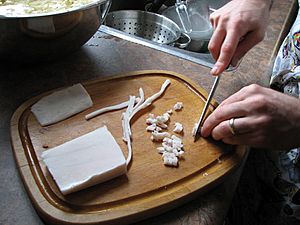
In Germany lard is called Schweineschmalz (literally, "rendered fat from swine") and has been a longtime favorite as a spread. It can be served plain, or it can be mixed with seasonings: pork fat can be enhanced with small pieces of pork skin, called Grieben (cf. Yiddish gribenes) to create Griebenschmalz. Other recipes call for small pieces of apple or onion. In English, however, schmaltz usually refers to kosher fat rendered from chicken, duck or goose.
Schmalzbrot ("bread with Schmalz") can be found on the menu in grounded restaurants or brewery pubs. Schmalzbrot is often served as Griebenschmalz on rye bread accompanied with pickled gherkin.
Vegetarian Grieben from onions or apples, which began as a makeshift means of diluting Schmalz in time of need, became rather popular on their own account because they allow for a specific taste and a lower fat content. Completely vegetarian Schmalz-like spreads based on vegetable fats use those ingredients as well. In Germany it is forbidden to use the term Schmalz for non-lard products.
In Poland lard is often served as a starter. It is mixed with fruit, usually chopped apple, and spread on thick slices of bread.
Other uses
Rendered lard can be used to produce biofuel and soap. Lard is also useful as a cutting fluid in machining. Its use in machining has declined since the mid-20th century as other specially engineered cutting fluids became prominent. However it is still a viable option. Lard and other animal fats were formerly used as an anti-foaming agent in industrial fermentation processes such as brewing; there, animal fats have been superseded by polyethers.
Images for kids
-
A triglyceride molecule, the main constituent of lard
See also
 In Spanish: Manteca de cerdo para niños
In Spanish: Manteca de cerdo para niños


